Redefining the role of arts research as creative recovery solutions
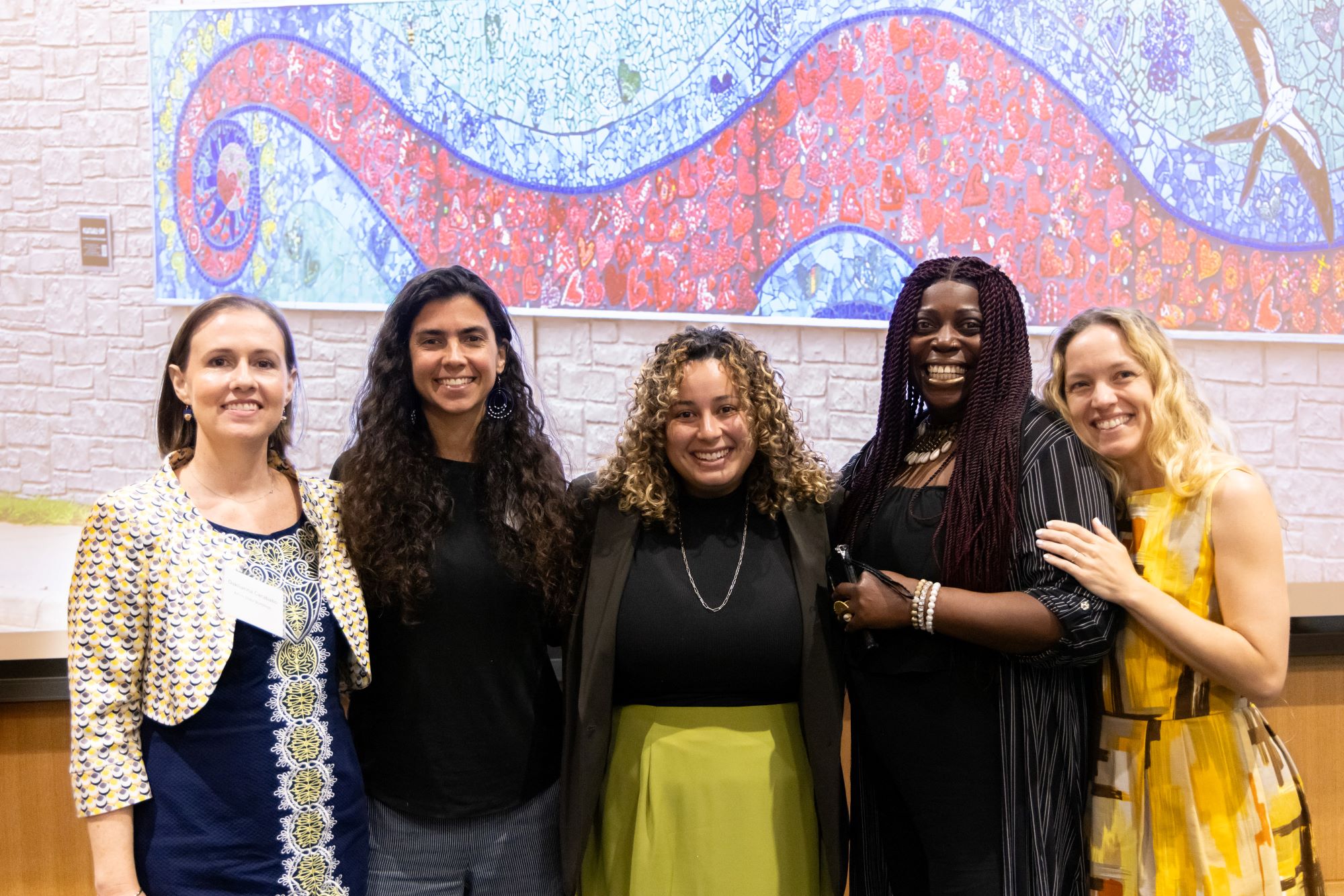
While we are trained in specific fields of study, the world is interdisciplinary. Sometimes the solutions to vexing or complex questions cannot be answered adequately within the boundaries of any given discipline.
The Recovery Through the Arts Convening, a culmination of the University of Florida College of the Arts’ 2024 Creative B Summer Program, brought together an array of artists, academics, and thought leaders in UF’s Malachowsky Hall to explore creative and collaborative solutions through interdisciplinary arts research.
Centering the relationship between the arts and public health as the lens through which “recovery” is understood, the convening expanded the roles, spaces, and possibilities that we traditionally assign to artists. Indeed, their work showcases the pre-existing yet ever-expanding frontier for the arts, including technological advancement and application, activism, public health, and community resources.
In the mosaic of a community, where do the artists fit? Do they observe from a distance, documenting and synthesizing the world around them? Do they envision and enact the future that they wish to see? Are they on the ground as forces of the present threaten the futures of their communities, serving as conduits for the needs of those around them? The convening sought to address these questions with visiting guest speakers and UF faculty serving as panelists.
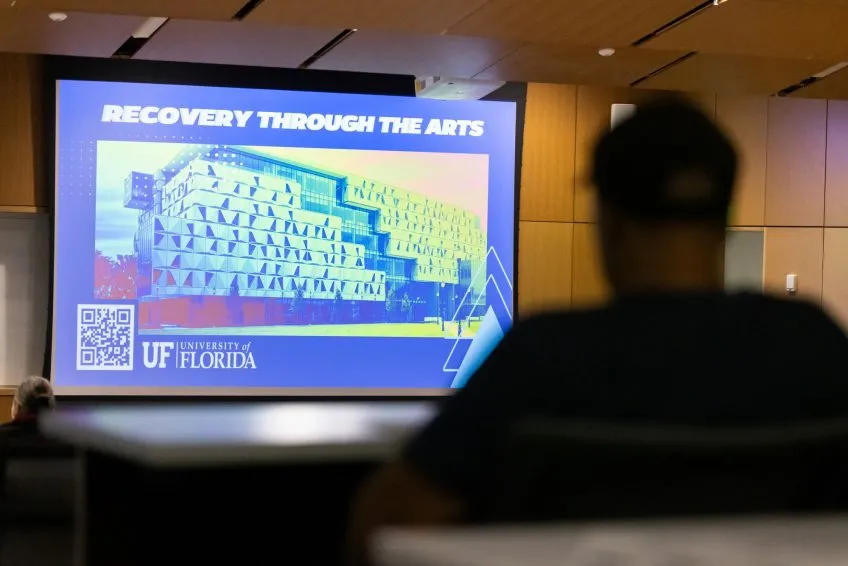
The day opened with the college’s Acting Associate Dean of Research and Strategic Initiatives, Colleen Rua, Ph.D whose research on care-based performance set the tone for the interdisciplinary themes engaged throughout the day. Rua centered the role of artists in Puerto Rico, particularly the Y No Había Luz theatre collective, following the devastation of Hurricane Maria in 2017, addressing climate and natural disasters through community engagement.
Does the making of art risk creating further trauma if it does not properly account for the impact its existence can have on survivors? While there is profound potential in applying the arts in this way, there is also a risk in causing more damage without grounded research, best practices, and human-centered standards that we can apply to minimize these risks.
When art and creative practices benefit public health and wellness
Recovery Through the Arts Convening panelists and presenters addressed questions such as how are we [artists] speaking up for community? How can a participatory community art project affect the trajectory of gentrification?
Public art projects like the recently unveiled HeART Wall: A Love Letter to Gainesville, led by UF Health Shands Arts in Medicine practitioner, Sarah Hinds, is a large-scale mosaic wall constructed by over 2,000 community members throughout Gainesville. It serves as an example of a participatory art project that successfully brought various local communities together.
“[The Heart Wall] instills a different kind of hope in the community,” according to Carla Lewis, SPARC352 Project Manager, since it creates an all-hands-on deck project.
“[This work] can’t be a phase,” Lewis says. It needs to be a sustainable practice for the community. Lewis underscores that along with having community represented in the art, they need to be represented in the bureaucratic processes surrounding public art projects.
Lewis finds recovery possible in the impact that public art programs have on the people who participate in them. If people are becoming healthier, if positive change is happening, if leaders are listening and responding to impacted community members with informed action, that is what gets her excited. She joined the SPARC352 initiative because she was able to discuss the honest history of community engagement with Gainesville institutions and she felt heard and empowered as a community leader.
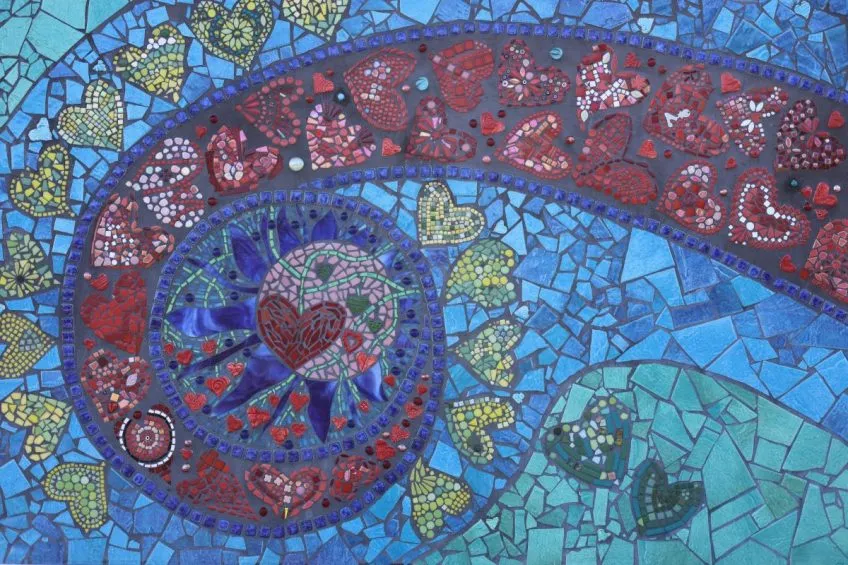
The sense of belonging created through art making like the HeART Wall, can become a counter to gentrification. Many of the creative practices about the relationship between arts in medicine have been employed by Gainesville’s communities, particularly its Black communities, for generations.
When public art provides a way for communities to recover from a history of shared trauma, it becomes a space for better health outcomes, for educating and empowering communities. For example, the recent One Nation/One Project GNV events used public art as a method of healing deep-seated trauma from youth gun violence incidents in the City of Gainesville.
Through a series of events, time and space was created for community members to make art, listen to music and dance, to breathe for a moment, and move toward recovery.
The concept of arts and medicine is not a new practice – it is a standardization and professionalization of a practice that has existed for generations. It draws on centuries of knowledge from cultures around the world encouraging the arts as a tool for healing and encouraging aesthetic considerations to create the best healing environments. Today we have the scientific evidence to understand how the arts can positively impact health and recovery time. The UF Center for Arts in Medicine and the UF Health Shands Arts in Medicine work together to research the impact of arts in medicine both in theory and practice.
Arts prescribing will eventually become a standard practice in healthcare, according to Jernie Millán, the Community Arts Coordinator for UF Health Shands Arts in Medicine. In addition to time in nature, arts and cultural experiences have been proven to support patients’ health and well-being.
There is value in using the arts as a tool to understand place-making practices in a specific time and place, and how we can in turn take this understanding to inform our entrepreneurial practices. Even the act of walking can benefit your creative practice and your health.
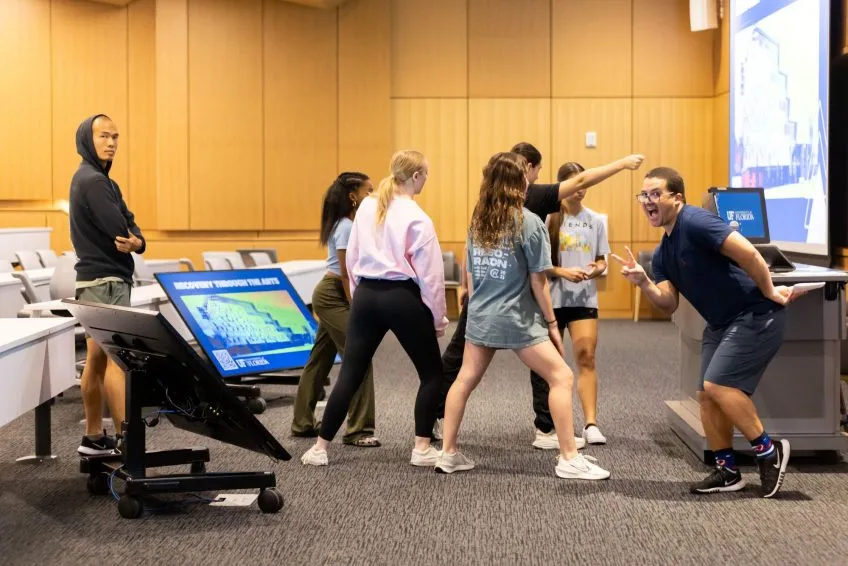
Assistant Professor Sarah Gamble in the School of Architecture creates walking experiences to prompt people to explore the environment and how their body moves through space. The significance of place making and understanding one’s relationship to their environment is explored through creative practices. These walking experiences are “dispensed” by a Walking Station which generates both detailed instructions for a 10-30 minute walk along with short literature on the topics of walking, the mind-body connection, and recovery, as well as a complementary creative exercise such as photography or collage.
One could even reconsider how an art institution can be in connection with community and provide a space for mindfulness and wellness through creative practices. Eric Segal, the Director of Education at the Harn Museum of Art, describes a museum as a space for wellness and for serving the community, which in turn can create spaces where people feel more comfortable engaging with art.
Mike O’Malley teaches a course in the UF Honors Program called “Making Place in Gainesville: How Creative Practices Shape Our City,” in which his students use storytelling, mindfulness, and visual communication to design solutions to real-world issues for local businesses. O’Malley seeks to make art accessible for people who don’t perceive themselves as “creative,” teaching artistry as a skill to develop rather than a gift only certain people receive. His course explores the question of who decides and who benefits when the arts are incorporated into economic and community development strategies.
How emerging technologies are being used by artists
Artists and creatives are reshaping how we envision the future with various communities, but how are they being intentional and focused in bringing these technologies into communities?
While acknowledging that the arts are uniquely situated to mediate and mitigate this potential disparity, there is a risk involved when engaging with emerging technologies, particularly with AI, and how those technologies could be further disadvantaging communities.
Associate Professor of AI and the Arts and Banks Preeminent Chair in the Digital Worlds Insititute, Amelia Winger-Bearskin, uses technology to consider how we engage with the environment around us and how to centralize indigenous values. Her artwork shows how AI can help conceptualize climate disasters, especially rising water levels that are on the forefront of Florida coastal concerns.
In the School of Theatre and Dance, Visiting Research Assistant Professor Braxton Rae and Associate Professor of AI and the Arts – Immersive Performance Technologies Heidi Boisvert, Ph.D, recently co-created an immersive theater production with UF students who actively engaged with advanced technologies, particularly artificial intelligence.
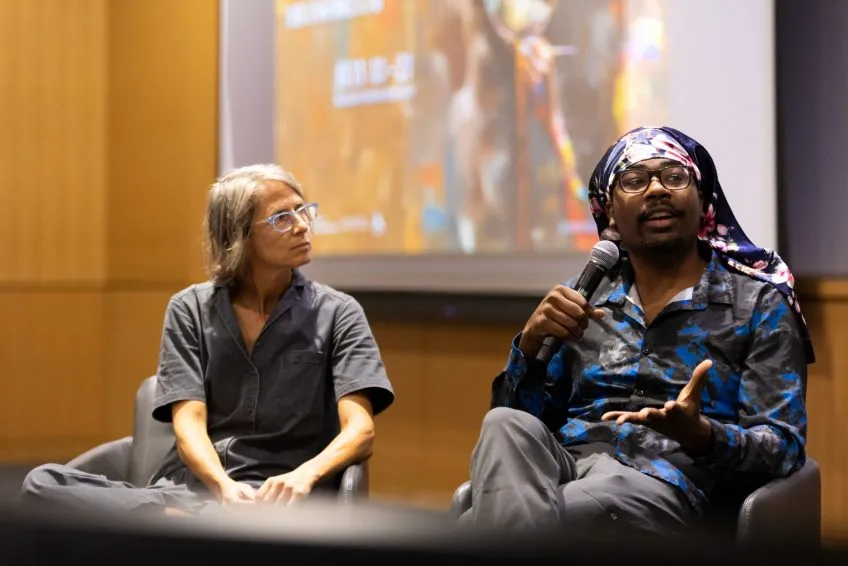
“Painting Humanity: An Immersive Journey Through Life’s Moments” took the audience through a nonlinear narrative timeline, centered on an artist grappling with universal themes that resonate with each of us, and pushed the audience to engage with AI directly during the performance. It embraced “technology as a creative partner” with AI playing a multifaceted role in the creative process, and blurred the boundaries between audience and performers, cultivating an immersive environment for participants.
Interdisciplinary artist, Marlon Barrios Solano further explores the boundaries of traditional arts and emerging technologies. This summer, Barrios Solanos was appointed as the next Maker in Residence at the UF Center for Arts, Migration, and Entrepreneurship (CAME) with a focus on AI and the Arts. He provided a live demonstration of his work during the convening, creating digital design to music while a small language model AI generated captivating images in real time informed by his designs and a set of search terms.
CAME director Oṣubi Craig praised Barrios Solano’s work in AI technology, noting that “as UF seeks to lead the way in exploring new AI applications, Marlon’s residency provides a perfect opportunity to examine the activation of AI into creative spaces to build new possibilities and horizons.”
Through this lens of imagining or speculating a different future using emerging technologies, artists and creatives embrace the unknown, showing us what could be possible.
Afrofuturism is seated at the “intersection between speculation and liberations” says the convening’s keynote speaker Julian C. Chambliss, Ph.D, Professor of English and the Val Berryman Curator of History at the MSU Museum at Michigan State University. His upcoming textbook “Mapping Afrofuturism” provides an in-depth historical overview, primary sources, and timeline to allow students to have a better understanding of the concept.
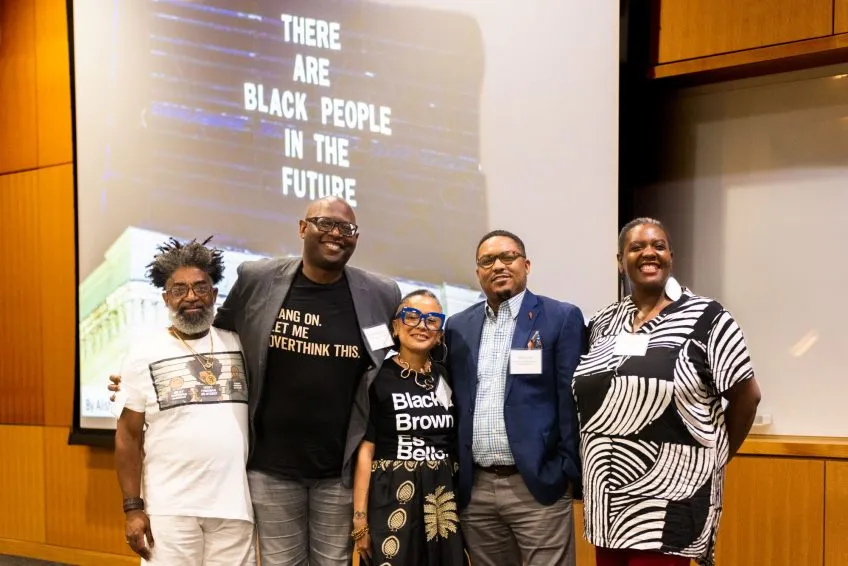
As an interdisciplinary teacher and scholar concerned with real and imagined spaces, Chambliss integrates a historical understanding into investigations of contemporary culture. His exploration of Afrofuturism as striving toward freedom requires us, as the audience, to see new paths and to imagine a different world—one focused on the collective good where coalitions bring resources together in the name of health, wealth and success for all.
It gives equal weight to the necessity of navigating trauma, but through the creative practice of centering joy. Making art is joyful, and joy helps us to overcome the gravity of trauma.
The Center for Arts, Migration and Entrepreneurship will further explore Afrofuturism with a week-long series of events in January 2025.
The Recovery Through the Arts Convening event was sponsored by the Center for the Humanities and the Public Sphere — and co-sponsored by the Center for Arts, Migration, and Entrepreneurship and the College of the Arts’ Creative B Summer Program — with support from the Office of the Provost.
 Featured Image Caption: Pictured from left to right: Oaklianna Caraballo (Art in State Buildings Specialist, University of Florida College of the Arts), Sarah Hinds (Visual Artist, UF Health Shands Arts in Medicine), Jernie Milan (Community Arts Coordinator, UF Health Shands Arts in Medicine), Carla Lewis (Project Manager, SPARC352), and Natalie Rella (Communications Specialist, UF Center for Arts in Medicine). Photo by Brianne Lehan.
Featured Image Caption: Pictured from left to right: Oaklianna Caraballo (Art in State Buildings Specialist, University of Florida College of the Arts), Sarah Hinds (Visual Artist, UF Health Shands Arts in Medicine), Jernie Milan (Community Arts Coordinator, UF Health Shands Arts in Medicine), Carla Lewis (Project Manager, SPARC352), and Natalie Rella (Communications Specialist, UF Center for Arts in Medicine). Photo by Brianne Lehan.